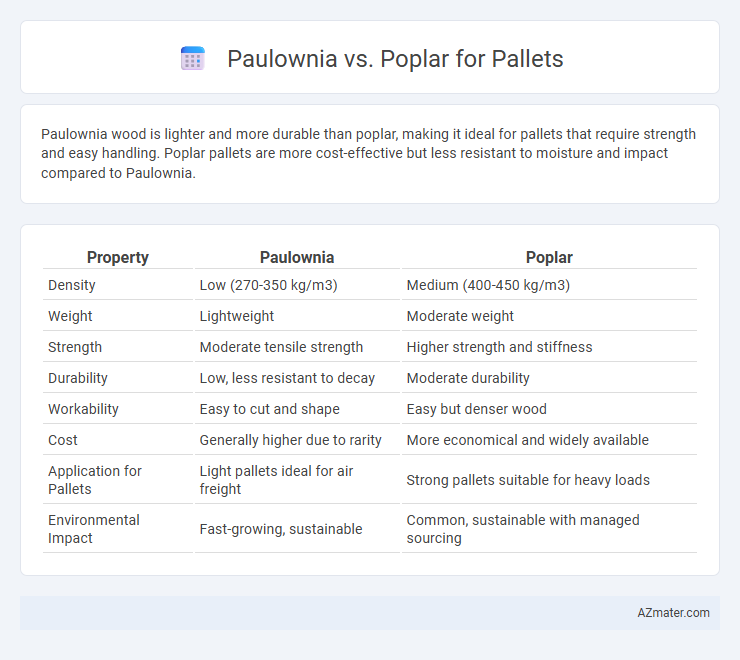Paulownia wood is lighter and more durable than poplar, making it ideal for pallets that require strength and easy handling. Poplar pallets are more cost-effective but less resistant to moisture and impact compared to Paulownia.
Table of Comparison
| Property | Paulownia | Poplar |
|---|---|---|
| Density | Low (270-350 kg/m3) | Medium (400-450 kg/m3) |
| Weight | Lightweight | Moderate weight |
| Strength | Moderate tensile strength | Higher strength and stiffness |
| Durability | Low, less resistant to decay | Moderate durability |
| Workability | Easy to cut and shape | Easy but denser wood |
| Cost | Generally higher due to rarity | More economical and widely available |
| Application for Pallets | Light pallets ideal for air freight | Strong pallets suitable for heavy loads |
| Environmental Impact | Fast-growing, sustainable | Common, sustainable with managed sourcing |
Introduction to Paulownia and Poplar
Paulownia and Poplar are two popular hardwoods used in pallet manufacturing due to their lightweight and durability. Paulownia wood is known for its rapid growth, low density, and high strength-to-weight ratio, making it ideal for lightweight pallets that reduce shipping costs. Poplar, although denser and heavier than Paulownia, offers excellent stiffness and resistance to impact, providing durable pallets suitable for heavier loads.
Botanical Overview: Paulownia vs Poplar
Paulownia trees belong to the Paulowniaceae family, characterized by rapid growth and large, heart-shaped leaves, while Poplar trees are part of the Salicaceae family, known for their fast growth and triangular to diamond-shaped leaves. Paulownia wood features a lightweight, fine grain with natural resistance to decay, making it suitable for durable pallets, whereas Poplar wood is slightly heavier, softer, and prone to wear but offers good workability for pallet manufacturing. Both species grow quickly and are sustainable choices, but Paulownia's superior strength-to-weight ratio provides an advantage in pallet longevity and performance.
Wood Density and Weight Comparison
Paulownia wood has a density of approximately 0.25-0.35 g/cm3, making it significantly lighter than poplar, which has a density around 0.40-0.50 g/cm3. This lower density results in lighter pallets when using paulownia, enhancing ease of handling and reducing shipping costs. Poplar pallets, while denser and heavier, offer greater strength and durability, making the choice dependent on the balance between weight and load capacity requirements.
Strength and Durability Factors
Paulownia wood offers superior strength-to-weight ratio compared to poplar, making it a lightweight yet resilient option for pallets. While poplar provides moderate durability, Paulownia's natural resistance to rot and insects enhances its longevity under heavy usage. Choosing Paulownia for pallets can result in longer-lasting, more reliable material handling solutions due to its exceptional structural stability.
Moisture Resistance and Stability
Paulownia wood demonstrates superior moisture resistance compared to poplar, making it less prone to swelling, warping, or rotting when exposed to humid environments. Poplar, while affordable and lightweight, tends to absorb more moisture, leading to decreased dimensional stability and reduced pallet lifespan. For pallet applications requiring durability in varying moisture conditions, Paulownia offers enhanced stability and longevity due to its lower water absorption rate and natural resistance to decay.
Workability and Processing Ease
Paulownia wood offers superior workability and processing ease compared to poplar, thanks to its lightweight structure and uniform grain that allows for faster cutting, sanding, and nailing. Poplar, while also workable, tends to have a slightly denser texture that can require more effort and time during machining and finishing processes. Manufacturers prefer paulownia for pallet production when prioritizing efficient handling and reduced labor costs.
Sustainability and Environmental Impact
Paulownia wood offers superior sustainability compared to poplar due to its rapid growth rate, allowing for quicker carbon sequestration and reduced deforestation pressure. Its lightweight and durable nature enhances pallet longevity, minimizing resource consumption and waste. In contrast, poplar grows slower and typically requires more intensive management, resulting in a higher carbon footprint and less efficient environmental outcomes for pallet production.
Cost and Economic Considerations
Paulownia pallets generally offer a higher initial cost compared to poplar but provide long-term savings due to their lightweight nature, reducing shipping expenses. Poplar pallets are more affordable upfront and widely available, making them suitable for cost-sensitive operations with high turnover. Evaluating total lifecycle costs, including durability and transportation efficiency, is crucial for determining the most economical choice between Paulownia and Poplar pallets.
Performance in Pallet Applications
Paulownia offers superior strength-to-weight ratio compared to poplar, making pallets lighter yet durable, which enhances handling and reduces shipping costs. Poplar provides moderate resistance to impact and wear but tends to be heavier and less resilient under heavy loads. Both woods allow efficient pallet construction, yet Paulownia's faster drying time and greater dimensional stability deliver enhanced performance in long-term pallet applications.
Final Verdict: Best Choice for Pallet Production
Paulownia offers superior durability and lighter weight compared to Poplar, making it an excellent choice for pallet production that requires strength and easy handling. Poplar, while more affordable and readily available, tends to be heavier and less resistant to moisture, which can reduce pallet lifespan. The final verdict favors Paulownia as the best choice for pallet production due to its balance of strength, weight, and durability, optimizing cost-efficiency and performance.

Infographic: Paulownia vs Poplar for Pallet
 azmater.com
azmater.com